Tidal Lagoons
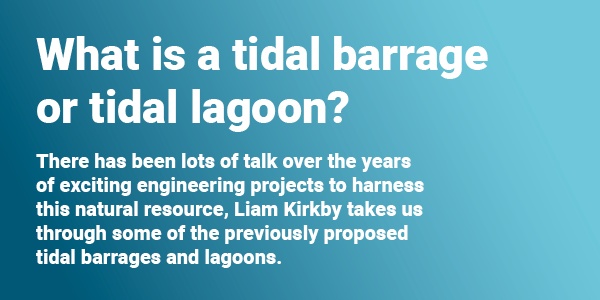
It is well known that the Severn Estuary has the second largest tidal range in the world and therefore has great potential to provide the UK with clean, low carbon energy. At OurTide we believe the Severn Estuary will be a major site for tidal energy generation. It is estimated that enough power could be harvested from the tide of the Bristol Channel to supply up to 7% of the UK’s total energy needs! [1] There have been lots of exciting ideas for engineering projects to harness this natural resource over the years and the image below shows some of the previously proposed tidal barrages and lagoons.
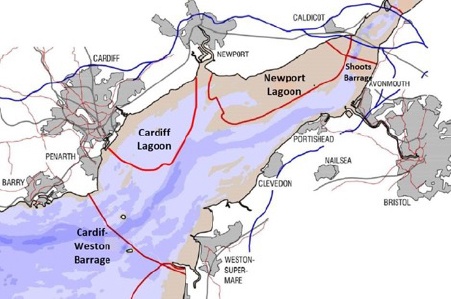
What is a tidal barrage or tidal lagoon?
Tidal barrages and tidal lagoons are two different types of tidal power generation technologies which can generate power simply by creating a difference in the height of water either side of a retaining wall.
> When the tide comes in, the area behind the wall is filled with water, free of charge, twice a day.
> When the tide goes out, the water is released across turbines to generate electricity.
A barrage is similar to a dam, installed across an inlet of the ocean. A barrage can operate in both directions to generate electricity from both incoming and outgoing tides. The La Rance tidal power station in France is an example of a barrage which powers approximately 130,000 houses a year [3]. This is actually a relatively small amount of power compared to the total potential output of the Bristol channel!
A tidal lagoon is formed by building a retaining wall across a bay or built out from the coast, instead of across the entire estuary. Ponds of water are formed at high tide and discharged across a turbine at low tide. There are currently no existing tidal lagoon power plants.
Could we have a tidal lagoon in the Bristol channel?
Several tidal lagoons have been proposed in the Severn Estuary including Newport, Cardiff and Swansea bay. The Swansea bay tidal lagoon was set to be the world’s first tidal lagoon, producing enough power for 155,000 homes [4]. However, the initiative did not receive sufficient support and will no longer go ahead. There remain no lagoons constructed for tidal power in the Severn Estuary.
A new tidal lagoon project requires investment of millions of pounds for the construction of the retaining wall and the project must undergo an assessment to determine the environmental impacts. However, if a lagoon was to already exist, the construction costs and additional environmental impacts could be greatly reduced in comparison to a new project.
What if there was already a lagoon in the Bristol channel?
Well, there is one… Oldbury Power Station was built in the 1960s. Its location on the south bank of the Severn Estuary can be seen on the map below. The power station used a lagoon to provide a constant source of cooling water to the now decommissioned nuclear power station, even when the tide was low.
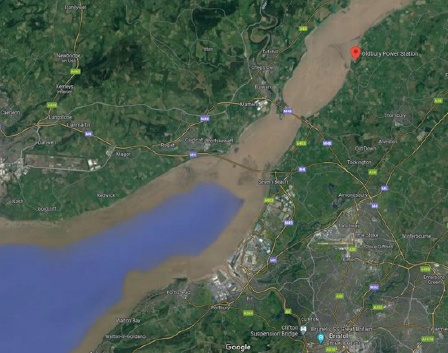
This image shows Oldbury power station, owned by Magnox Ltd, with the cooling water lagoon clearly visible on the bank of the Severn. In order to generate electricity, the lagoon would need to be modified to install turbine generators and sluice gates, as well as additional measures engineered to prevent the lagoon becoming filled with sediment over time.
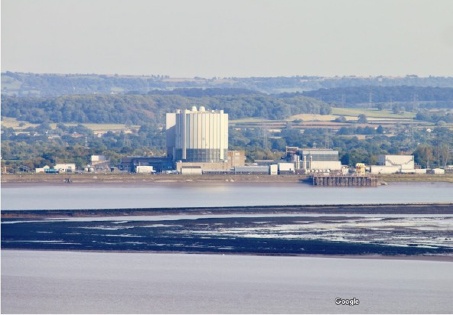
Why would this make a good site for a tidal power station?
Oldbury was previously a power station, therefore the grid connection and power take-off infrastructure is already well established right next to the lagoon. Magnox who presumably owns the lagoon even have relevant experience in hydropower:
“Maentwrog, Magnox’s last remaining generating site, is a 30MW hydroelectric station on the banks of the Dwyryd Estuary near Blaenau Ffestiniog in North Wales” [5]
The vast scale of the lagoon, almost reaching half the width of the Severn, can be seen in the image below. The lagoon holds 2.4 million cubic metres of water behind the retaining wall when tide is out [6]. This is equivalent to 960 olympic swimming pools! We estimate conservatively this could power at least 550 homes per year.
Whilst this may sound like a small number of homes compared to La Rance or the proposed Swansea Bay project, a small project may be advantageous as a starting point for tidal projects in the Severn Estuary. An independent review conducted for the government, the Hendry Review concluded that “there is considerable value in a small (less than 500 MW) pathfinder project” [7]. With the retaining wall and grid infrastructure at Oldbury already existing, this could be the ideal opportunity for a project of this kind.
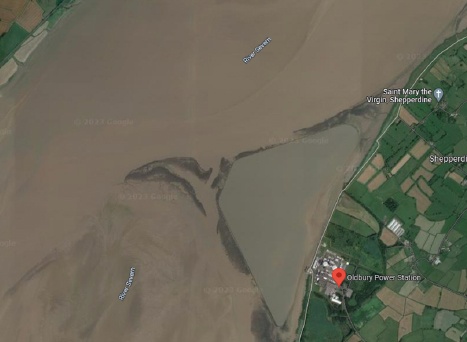
Could we use Oldbury lagoon to produce energy from the tide?
Absolutely, the idea was previously suggested by Sustainable Thornbury [8] to use the existing sea wall at Oldbury as a study for producing energy using tidal lagoons in the Bristol channel. The case for tidal lagoons in the Bristol channel was recently mentioned by West of England Mayor Dan Norris and is also being backed by a group called the Western Gateway.
OurTide would like to explore this idea to use Oldbury as a pathfinder project and campaign for the first tidal lagoon power station to be built at Oldbury. The project would harness the tidal resource available, using an already existing lagoon, to generate reliable and clean power. We hope this project could be the catalyst for further deployment of tidal technologies in the Bristol channel, by showing strong evidence for the potential of this energy resource on our doorstep.
For more information about the unusually large tidal range in the Bristol Channel, see the article Tides and the Bristol Channel by our friends at Clevedon Pier.
References
[1] Institute of Civil Engineers, “Tidal energy from the Severn Estuary” Accessed April 2023
[2] Mike Murphy, “Turning Back the Tide”, April 2021, Accessed April 2023
[3] thegreenage, “Rance Tidal Power Station, France”, Accessed April 2023
[4] Tidal Lagoon Power, “Swansea Bay: Key Statistics”, Accessed April 2023
[5] Magnox, Electricity Generation, Accessed April 2023
[6] Environment Agency “Cooling Water Options for the New Generation of Nuclear Power Stations in the UK ”, June 2010
[7] GOV.UK, “Independent review into the strategic role of Tidal Lagoons in the UK published”, January 2017
[8] J Gash, Sustainable Thornbury, “Oldbury Tidal Reservoir, Physical Description Report: Tidal Twin Reservoir”, October 2007
